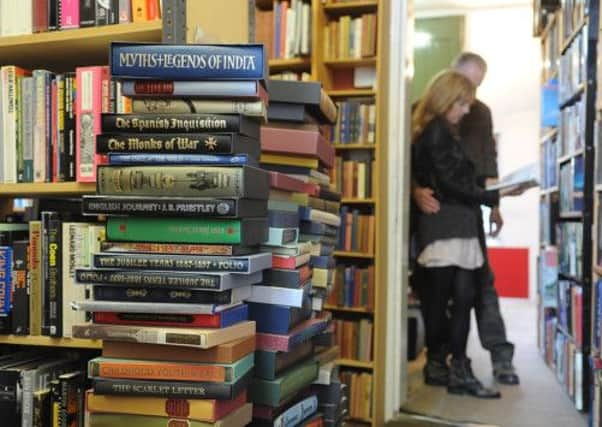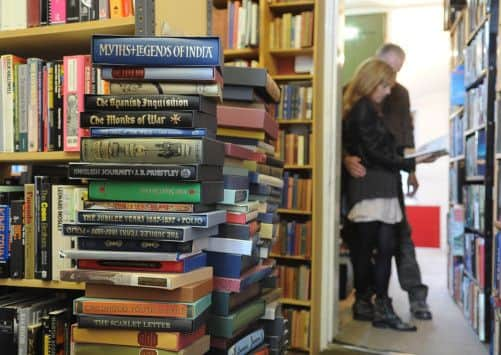Video: Between the sheets at York’s Book Fair


Tony Fothergill is enthusing about York’s forthcoming Book Fair – Britain’s biggest, with more than 200 dealers from as far away as Hong Kong, Israel and Vancouver – when a customer hands him a book she wants to buy.
This is always a potentially marvellous moment at Ken Spelman Books, York’s oldest bookshop (1948) and a Micklegate institution, with its burnished shelves and its air of being the plush private library of a discerning gentleman’s club.
Advertisement
Hide AdAdvertisement
Hide AdA purchase paves the way for the hallowed ritual of The Wrapping of the Book. Fothergill, the shop’s owner, duly whips out a sheet of bright green wrapping paper from under the counter. “You’d like it wrapped?” he says. No, says the customer, she doesn’t need Huddersfield – A Most Handsome Town wrapped.


“Oh, go on,” I say and she says okay then, and Tony carefully places the most handsome book on the bright green paper and folds one way, then folds another and turns down the corners, and – hey presto – it’s like literary origami. In 15 seconds, he has created The Perfectly Wrapped Book. “Look at that,” says the customer. “I don’t really want to open it now, it looks so special.”
It’s this sort of personal service – the sort you don’t get on the internet – that will draw probably 2,000 customers to York Racecourse next weekend for the 38th York National Book Fair, a jamboree of rare, out-of-print and collectable books, with likely sales of around £500,000.
Fair-goers regularly fly in from Germany, Holland and Belgium. The cheapest books will cost just a few pounds. And the most expensive? Possibly a three-volume first-edition set of The Lord of the Rings. Described as “near fine, tight, clean copies... Top edges of all three books are still a nice deep red”, they’re yours for £27,500.
Advertisement
Hide AdAdvertisement
Hide AdTolkien is mainstream stuff alongside the specialist areas of some of the exhibitors: slavery, Yorkshire parish registers, “early chess”, James Bond, Olympic Games, girls’ school stories, “small military campaigns”, Wirral topography, “counter culture”, the Catholic Apostolic Church.


“York was in the forefront of book fairs outside London,” says Fothergill, who has managed the event for over 10 years. “We started in 1974 with about 20 dealers and it has gradually outgrown every venue we could find in York.” It has also outgrown early dealers’ suspicions that fairs would damage their trade. “Booksellers were very protective of their customers. There was a fear that people might drift across the room to another bookseller. It was a jealously guarded trade.”
Not now. Book fairs are convivial, clubbable events. “There’s a networking element in them,” says Janette Ray, the fair’s publicity manager. “It’s an important way for booksellers to meet each other. And there’s a very buzzy atmosphere at the York fair. It’s got a hum about it.”
Unlike Janette, who has a shop in York’s Bootham, many dealers now work from home (we’ll come to the impact the internet has had on the trade) so fairs are like reunions, getting dealers out on the road and swapping gossip. And it’s a chance for them to meet customers and put faces to addresses and credit card details.
Advertisement
Hide AdAdvertisement
Hide AdJanette’s powder-blue-painted shop, in a timber-framed building dating back to the 15th-century, specialises in books on architecture, design, art, photography and gardens. She too hand-wraps: blue paper this time. “The outside world views you by how you wrap your books,” she says. “They’re your signature.”
As we speak, the phone rings. It’s a regular customer who collects books on tombs and memorials. I suggest that book-collecting attracts its fair share of eccentrics. “I think ‘single-minded people’ is a better term, myself,” she says. “Some people have very niche collecting interests – books on light fittings, or grand ocean liners.”
If you’ve been searching for years for Unknown Crusader Castles or Stained Glass Tours in Spain and Flanders or Building in Cob, Pisé and Stabilized Earth (basically about mud houses), this is the place to come.
The internet, however, means that fewer people now search for books in person; with computer access to a book-selling site, the click of a mouse can guarantee the thud of a parcel on the front doormat. It may have none of the quiet joy of browsing shelves and handling books, the thrill of the chase or the serendipity of discovering a previously unknown treasure, but, well, we live in an age of instant digital gratification.
Advertisement
Hide AdAdvertisement
Hide Ad“You can find a book in five minutes that you might have looked for for five years.,” says Janette. “The effect has been that the price of easily accessible books has gone down, but the price of collectable books has gone up. It means that booksellers are continually looking for a copy with something that make it unique, books that have something quirky about them – signed, annotated, associated with someone important.
“It’s the book as an object. The negative impact of the recession has been the closure of many small bookshops. But its positive impact has been at the more expensive end of the market. People who have money may invest in objects rather than put it in the bank.”
There’s no avoiding the internet as I wend my way across York city centre, taking in all its 11 bookshops, which include two Oxfams. Most stretch in an almost straight line that starts just up Bootham, at Taikoo Books (specialising in “Africa and the Orient”).
There are some fascinating shops here – Minster Gate Bookshop, where the floors go further up and up and up, and the Barbican Bookshop, where the rooms go back and back and back (stop when you reach the propped-up copy of Our Friend the Welsh Corgi in the final room). It has a strong theological section, as does St Paul’s Bookshop, were you can also stock up on vestments, altar candles and DVDs of St Etheldreda, Abbess of Ely.
Advertisement
Hide AdAdvertisement
Hide AdLucius Books is bright and modern, nearby Fossgate Books particularly helpful and friendly. Here Alex Helstrip bucks the trend by selling purely through his shop. “It’s not the same experience on the internet,” he says. “People still enjoy coming into a second-hand bookshop. It’s become a leisure activity in York – going round the Minster and going round the bookshops. People know that because of the quantity of bookshops here they’ll find something of interest.”
Along Walmgate, Stone Trough Books shares premises with Philip Martin Music Books. Stone Trough’s George Ramsden will be exhibiting at the book fair, organised by the PBFA (Provincial Booksellers’ Fairs Association). “You see people at fairs you never see in the shop; they don’t overlap.”
Finally, back at Spelmans, Tony Fothergill reflects: “What the internet has done is sharpen up bookshops. You can buy a lot of books on it for basically the price of postage – the sort of books that are printed in vast quantities. So it doesn’t make sense for bookshops like mine to stock them; it clogs the shelves up. You could fill your shop ten times over with books no-one wants.”
More specialist books find an eager internet market, though. A book on Persian grammar “flew off” the website; he could, he says, have kept it purely on the shelves and a buyer might never have come in.
Advertisement
Hide AdAdvertisement
Hide AdEven so: “A very large proportion of the books that will be at the fair you won’t find on the internet. The sense is that everything is online, but it’s not.”
Certainly not the ritual of The Wrapping of the Book.
York National Book Fair is being held at the Racecourse’s Knavesmire Suite on Friday, September 20 (noon-7pm) and Saturday, September 21 (10am-5pm). Admission £2 or download a complimentary ticket from www.yorkbookfair.com. Free shuttle bus from York railway station. Information on 01904 624414.
The rare books which have made a mint
Gutenberg Bible: The first major work to be printed with movable type, this is the big one when it comes to rare books. A perfect copy hasn’t changed hands in years, but in 2007, a single leaf went on sale for £47,000.
Shakespeare First Folio: The first authoritative collection of Shakespeare’s plays ever published, only 750 were printed and in 2006 a copy came up for auction at Sotheby’s where it went for £2.8m.
Advertisement
Hide AdAdvertisement
Hide AdThe Codex Leicester: A notebook of scientific observations produced by Leonardo da Vinci between 1506 and 1510, the work was never intended for publication. It runs to just 72 pages, but when Bill Gates bought it in 1994 he didn’t get much change from £20m.
Ptolemy’s Geographia: The scientist, who lived around 100AD, produced several significant works, including Geographia, which mapped the world as he knew it. Original copies, which contained hand-drawn maps, have been lost to history, but printed first editions have sold for £2.5m.
John James Audubon’s Birds of America: Made up of individual plates, only around 120 complete copies of the work by the naturalist and painter are thought to exist, with one selling in 2000 for £5.6m.